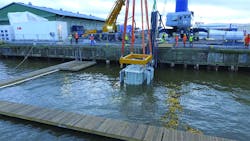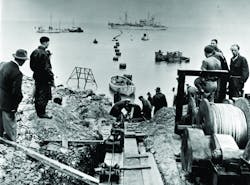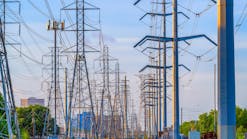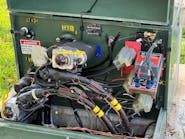There are thousands of miles of undersea power cables on the seabed, so why not put a power grid down there too? That idea has been popping up for many years with all the oil rigs, gas platforms and wind farms appearing offshore. It’s one of those technological applications where the theory has been around for a long time, but the technology had not matured to the extent that it was possible. The idea is simple enough, but there needed to be a great deal of study along with research and development (R&D) to be able to actually do it.
In the last few years, the technology has finally caught up to the concept. Manufacturers such as, ABB; Siemens; Baker Hughes, a GE company; Schneider Electric; FMC Corp. and several others have developed electric apparatus (transformers, switchgear, variable speed drives, etc.) for an alternating current (AC) undersea power grid.
Moving to the Seabed
R&D motivation has come from the oil and gas industry as it looks for ways to reduce production costs. By moving equipment (compressors, pumps, processing plants, etc.) to the seafloor, the industry can increase production efficiency, but the equipment needs electric power. So, it only makes sense to move the AC power grid down there too. Moving production equipment off the platforms to the seabed has a lot of benefits other than efficiencies.
The seabed removes the risks from surface hazards such as extreme weather (cyclones, hurricanes, typhoons etc.) events. It also reduces marine pollution and simplifies decommissioning. It’s more environmentally friendly since it decreases the carbon footprint (energy and CO2 emissions are lowered) of the facility by using cleaner electricity from onshore rather than offshore diesel generation, but it isn’t easy.
The undersea power grid has some major design parameters. A deepwater installation needs the ability to be installed at depths near 10,000 feet (roughly 3,000 meters). It also needs the ability to be located far from shore approximately 370 miles (600 km). In addition, it must be deployable to remote locations. These are formidable requirements, but not impossible, and digital technology is mission-critical. Add in artificial intelligence for big data management, and autonomous control makes this feasible.
Partnerships
ABB, Chevron, Equinor (formerly Statoil), and Total formed a group known as the Joint Industry Project (JIP). According to a press release, the JIP has been in the works since about 2013. Their goal has been to develop a 100 MW (megawatt) transmission and distribution power system for subsea pumps and gas compressors operating on the seabed, using specially adapted “off the shelf” equipment.
ABB recently announced it has finished its 3,000-hour shallow water 20 feet (7 m)-test of a complete subsea power system in Finland. The system consisted of two variable speed dives in parallel, combined with subsea switchgear and controls. With this testing successfully completed, ABB is planning to move on to the actual installation of its first underwater electric power system sometime in 2020.
Siemens announced it had successfully completed the first phase of its shallow water testing of its Subsea Power Grid project. This development program was a collaboration with partners Chevron, Equinor, ExxonMobil, and Eni Norge and the testing took place in Trondheim, Norway. A Siemens press release said, “The Subsea Power Grid system consists of a subsea transformer, subsea switchgear, subsea variable speed drive (VSD), subsea wet mate connectors, and a highly reliable remote control and monitoring system that includes cloud-based user dashboards and data analytics.”
Siemens’ press release went on to say, “This is the world’s first subsea power grid designed for distribution of medium voltage power using pressure compensated technology. The initial results from the shallow water testing were positive and all units operated within their design parameters.”
Blueye Robotics has a short video showing the underwater testing of the equipment that is pretty interesting. It can be found at the following link: https://www.youtube.com/watch?v=DiQ3_tb_hrk.
Offshore Wind
The gas and oil companies might be the driving force moving undersea power grids off the drawing boards, but they’re not the only ones interested in the technology. Offshore wind farms have several commonalities with offshore gas and oil fields. This is a lot of individual connections to the wind farms’ collector system. The facilities are expensive and require a great deal of infrastructure, a lot of which is on the seafloor. According to Wind Europe, as of 2018, the total offshore wind capacity for Europe is 18,499 MWs. The report said, “This corresponds to 4,543 grid connected wind turbines across 11 countries.”
That is a lot of individual undersea connections to the wind farms’ collector system. Without going into a lot of detail, each turbine is connected to a medium voltage (MV) collector system where the power produced by the turbines is gathered. This requires many topside platforms with switchgear, transformers, and a whole lot of cabling. The wind turbines can be connected in a radial or star configuration. From there, power moves to a central point and finally from the wind turbine array via a transmission link to the onshore power grid. Like the gas and oil facilities these power grid elements would be better on the seabed, removing all surface platforms.
The gas and oil fields require electricity brought to the fields. The wind farm need a connection for the power produced at the farm. Both of these facilities rely on transmission links for the connection. The transmission can be either HVAC (high voltage alternating current) cables or HVDC (high voltage direct current) cables. For HVAC there is a real problem with the longer cable lengths required to connect these distant fields. It’s called reactive compensation.
HVAC cables need reactive compensation in the form of shunt reactors because of capacitive charging currents. Shunt reactors are needed at both ends for cable lengths around 60 miles (100 km) to 90 miles (150 km) depending on the type of cable.
Talking with Dr. Ram Adapa, technical executive in EPRI’s (Electric Power Research Institute) power delivery and utilization sector, about HVDC and offshore installations was very interesting. Dr Adapa said, “The breakeven distance between HVAC and HVDC offshore is approximately 30 miles (50 km) to 60 miles (100 km). The cost to compensate for this reactive power and ensure appropriate active power transfer is higher for HVAC than it is for HVDC beyond the breakeven distance.” Thinking this over, it appears that it would be beneficial to have an AC seabed power grid connected to an HVDC system to bring the power onshore.
HVDC Connection
Since we’re discussing HVDC links, a little background information is needed for clarification. There are two HVDC technologies being used today. The oldest is the thyristor-based technology known as the line commutated converter (LCC). ABB commissioned the first undersea LCC based HVDC power link between the Swedish mainland and Gotland Island in 1954. Then in 1997, they commissioned the first IGBT (insulated-gate bipolar transistor)-based VSC (voltage source converter) technology also on Gotland Island. Since then, the VSC HVDC technology has proven to be particularly valuable for offshore applications.
Adapa explained, “There are multiple advantages to VSC offshore applications such as more compact converter stations with less or no filtering, which is particularity advantageous for offshore. It also offers independent control of active and reactive power along with the ability to connect weak AC grids. Another advantage is the fact that a VSC HVDC system has lower line losses than HVAC and there is no potential for resonance between the offshore cable and the onshore grid. In addition, VSC offers zero power operation, while LCC requires a minimum power transfer to stay connected.” This technology has proven so positive that it has been used in all offshore HVDC connections so far.
HVDC Power Grid
It may seem we have wandered a bit from the original focus of the subsea power grid, but that hasn’t happened. Like the land based power grids, both AC and DC technologies are needed for the complete system. The AC based subsea power system is being installed in pilot projects and it is expected, once the newness wears off, there will be a lot of projects deployed.
It also brings up the question of how far behind are underwater HVDC systems. The crystal ball is cloudy, but several years ago, ABB and GE announced they had each developed a hybrid HVDC circuit breaker. This device is a key part of the technology needed for an integrated AC-DC grid. The puzzle pieces are falling together.
Once the AC subsea power grids become established, it’s only a matter of time until HVDC technology is applied to this area too, but there is a lot of work to be done for an AC-DC future grid. There are so many new building blocks coming along for tomorrow’s underwater grid. The challenge is linking them all together and proving the concepts with operating experience!




